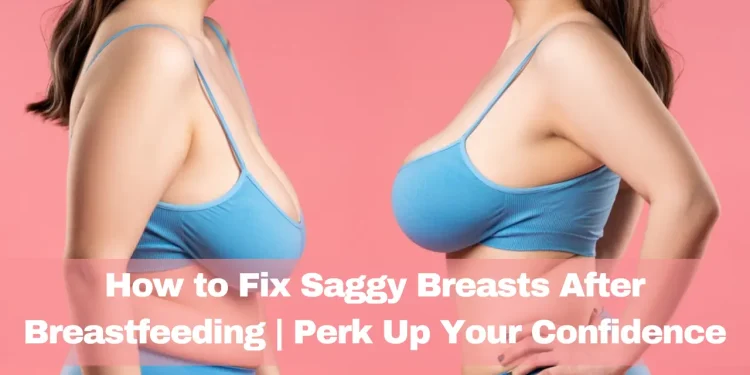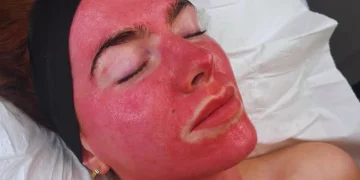Women worry about sagging breasts after breastfeeding. Breastfeeding may reduce breast volume and suppleness. Sagging, drooping, or deflated breasts may develop. Though conventional, some women may find this technique irritating or humiliating. This blog post discusses “fix saggy breasts after breastfeeding.”
Understanding the Causes of Saggy Breasts After Breastfeeding
The changes that occur in the breasts during pregnancy and breastfeeding
Pregnancy prepares breasts for breastfeeding. More progesterone and estrogen promote milk duct and breast tissue growth. Breasts may expand and become more sensitive.
Nursing activates a woman’s milk ducts. Breast tissue engorgement makes breasts seem full and heavy. When the baby feeds and releases milk, the breast tissue gradually regains its pre-pregnancy size and shape.
However, breastfeeding may make the skin less elastic and lose volume. After weaning, the breasts may seem deflated or drooping.
Age, weight gain during pregnancy, genetics, and breastfeeding length might affect the severity of these changes.
How can these changes cause breasts to sag?
Due to the stretching and shrinking of the breast tissue, breastfeeding, and pregnancy may result in sagging breasts. Due to hormonal changes and the growth of milk-producing glands, a woman’s breasts significantly enlarge during pregnancy. The breast’s skin and ligaments may expand due to this size growth, losing suppleness.
When nursing, breast tissue might lose its form and firmness because of the frequent pushing and straining the baby’s feeding causes in the skin and ligaments. In addition, a woman’s breasts may suddenly lose volume after she stops nursing, which may cause sagging.
Because aging causes the skin to lose elasticity, the woman’s age also affects how much she fades.
Additionally, heredity and weight loss or growth may influence the degree of drooping breasts.
Other factors that can contribute to saggy breasts.
In addition to pregnancy and nursing, several additional causes may cause pendulous breasts, including
- Age: Women’s skin loses elasticity as they age, which may damage the ligaments that support the breasts, causing them to droop.
- Sagging breasts may result from the tissue losing volume due to significant weight loss.
- Genetics: Sagging breasts may occur in specific individuals due to a hereditary predisposition to have less breast tissue or poorer supporting ligaments.
- Smoking: Smoking may hasten the aging process of the skin, which can result in drooping breasts.
- Sun damage: Skin damage from ultraviolet (UV) ray exposure may result in sagging breasts and a loss of skin elasticity.
Tips for Preventing Saggy Breasts during Breastfeeding.
Advice for women who are currently breastfeeding or planning to breastfeed.
Breastfeeding moms may avoid drooping breasts by doing many steps:
- Use a supportive bra: A well-fitted bra may reduce breast tissue tension during breastfeeding. Fitting and supportive bras are recommended.
- Hydrate: Staying hydrated may keep breast tissue supple. A large water intake may help produce healthy breast milk.
- Eating a balanced, vitamin and mineral-rich diet may prevent healthy breast tissue and drooping.
- Exercise: Daily exercise can firm and supple breast tissue.
- Avoid rapid weight loss to avoid drooping breasts.
- Nursing positions might help breasts recover faster. Ask a lactation professional about breastfeeding positions.
The importance of wearing a supportive bra
Supportive bras throughout and after pregnancy and nursing help breasts remain healthy. Supportive bras prevent breast tissue tension and drooping.
Pregnancy and breastfeeding alter breasts. Painful breast ligaments may weaken. A supportive, well-fitting bra may decrease breast soreness. It may help reduce breast weight-induced sagging.
Supportive bras may improve breast milk quality. Maintaining breast tissue may enhance milk flow and avoid duct blockages.
Use a supportive bra regularly to tighten breasts after breastfeeding. A well-fitting bra may reduce breast drooping when breast tissue loses volume.
Bra fitting and support. Drooping and pain may result from tight or loose bras. Fitted bras are excellent.
Exercises to Tighten Saggy Breasts
Exercises may tighten sagging breasts. Practice these:
- Lying on your back with bowed knees and flat feet, your chest press. Lift each dumbbell to your shoulders with your hands facing the front. Lower dumbbells slowly.
- Plank position for push-ups, with hands just wider than shoulder width. To lower and raise yourself, bend your elbows.
- Dumbbell fly:
- Lie back with knees bent and feet flat.
- Lift each dumbbell to your shoulders with your hands facing each other.
- Slowly raise your arms above your chest.
- Arm curls with dumbbells shoulder-width apart. Raise your palm-facing arms. Slowly raise and lower shoulder dumbbells.
- Face a wall with your arms extended and palms flat. Lean against the wall and continue.

Non-Surgical Remedies for Saggy Breasts.
Droopy breasts may be improved non-surgically or surgically. Some options:
- External creams and lotions claim to tighten and lift drooping breasts. These lotions include retinol, collagen, and vitamin C, which may improve skin suppleness.
- Breast massage stimulates collagen and elastin production, circulation, and lymphatic drainage. Gently massage your breasts daily.
- Improve your posture: Poor posture weakens chest muscles and causes sagging breasts. To improve posture, stand upright and tense your back and core muscles.
- Supportive bras: A supportive bra may raise and firm the breasts when exercising. Look for bras with wide straps that disperse weight and support.
- Healthy habits: Exercising, eating well, and not smoking may improve skin elasticity and breast health.
Surgical Options for Saggy Breasts
Non-surgical treatments for droopy breasts may fail. Sagging breast surgeries:
- Mastopexy reconstructs drooping breasts. They were tightening surrounding tissue and removing excess skin contours breasts. The areola and nipple go to a younger breast.
- Breast reduction: Large breasts may cause back, neck, and other issues. Removing breast tissue and skin improves size and contour.
- Implants shape and enlarge breasts. Implants may go above or below the chest.
- Combination surgeries may raise and enlarge breasts.
Conclusion
Many women worry about their breasts drooping, particularly after giving birth and nursing. While non-surgical treatments, including topical creams, breast massage, better posture, supportive bras, and good living choices, may also help reduce the look of droopy breasts, they are not as successful as surgical methods. Speaking with a trained healthcare professional is crucial to choose the best course of action for your unique circumstances. Regardless of your chosen strategy, taking care of your breast health is vital for total physical and emotional well-being.
Read –














